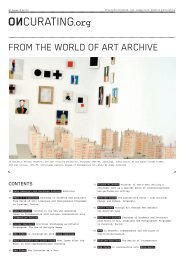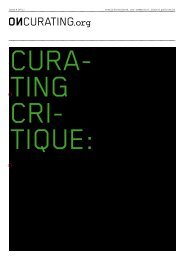You also want an ePaper? Increase the reach of your titles
YUMPU automatically turns print PDFs into web optimized ePapers that Google loves.
02 Issue # 11/11 : PublIc Issues<br />
editorial<br />
Selma Dubach & Christoph Schenker<br />
This edition of On-curating.org deals with <strong>as</strong>pects of the public sphere, public space,<br />
and public art in seven different metropolises around the world. The point of departure<br />
w<strong>as</strong> a competition that w<strong>as</strong> held for a m<strong>as</strong>ter plan for public art in the new Europaallee<br />
district in the centre of Zurich, the first such plan in Switzerland.<br />
In his article "The Tree-lined Road to Europe," the urbanist Richard Wolff presents<br />
the urban development project Europaallee, which is currently being built, and traces the<br />
around 50-year-long historical development of the project and its changing politico-<br />
economic conditions. Due to the central location and the high investment volume of 2 to<br />
2.5 billion Swiss Francs, Europaallee is an extraordinary building project for Switzerland.<br />
A venture of this magnitude h<strong>as</strong> to be seen in a global context. With Europaallee, the<br />
neoliberal city of Zurich is bolstering its position <strong>as</strong> a global city that is competing<br />
with other global cities economically. Europaallee is de facto an expansion of Zurich’s<br />
central business district and <strong>as</strong> such seems to demand a cultural prop in the form of<br />
public art. To arrive at a curatorial concept for art in the Europaallee district, the<br />
City of Zurich and the Swiss Federal Railways held a two-stage competition in 2009 and<br />
2010 (a selective procedure with prequalification).<br />
What functions does public art claim to fulfil in the given economic and social context?<br />
What understanding of the public sphere underlies public art? And how does it create room<br />
for public activities? Our aim here is not to <strong>as</strong>k and answer these questions b<strong>as</strong>ed on<br />
the competition entries. Rather, we are interested, taking the globally networked space<br />
of Europaallee <strong>as</strong> a starting point, in broadening our perspective and putting up for<br />
discussion how artists, curators, urbanists, and cultural studies experts in other cities<br />
think and act. This edition of On-curating.org is a mosaic consisting of different per-<br />
spectives of different authors from different disciplines from different big cities across<br />
the globe. It creates a picture of what the public sphere, public space, and public art<br />
can mean today against the background of regional conditions.<br />
Under the title "The Production of the Public. Experiences from Mumbai," the architect<br />
Rupali Gupte and the urbanist Pr<strong>as</strong>ad shetty impressively examine concrete urban formulations<br />
and different scopes of the much-discussed concept "production of space" in<br />
the Indian metropolis Mumbai. In his article "Understanding the Public and the Chinese<br />
Contemporary," curator and critic li Zhenhua, who divides his time between Beijing,<br />
Shanghai, and Zurich, investigates the changed public sphere in China and the possibility<br />
of artists to interact with the Chinese public. In this context, he traces the social and<br />
political developments of his home country over the l<strong>as</strong>t forty years. In the essay "A<br />
Different Sense of Space. Public Spaces in Tokyo and Shanghai," the cultural theorist and<br />
photographer Jürgen Krusche shows the different notions and perceptions of the public<br />
sphere in the two Asian metropolises Tokyo and Shanghai. Even today, historical developments<br />
of private and public life in these cities give rise to divergent usages of public<br />
space. The artist Minerva cuev<strong>as</strong> discusses the ways in which art uses public space in<br />
the megalopolis Mexico City. The works discussed in "Mexico City and the Construction of<br />
its Public Sphere" range from conceptual (Gabriel Orozco) to socially involved, activist<br />
works (Abraham Cruzvilleg<strong>as</strong>). The theoretical discussion of the artist collective Oda<br />
Projesi (which literally means "room project") in the article "Spatial Practices of Oda<br />
Projesi and the Production of Space in Istanbul" by the cultural studies expert Derya<br />
Özkan is followed by a conversation between Özkan and the three members of the collective<br />
entitled "Art’s Indecent Proposal: Collaboration. An Attempt to Think Collectively."<br />
The article addresses issues related to location and neighbourship, <strong>as</strong> well <strong>as</strong> the possi-<br />
bility to create (social) space through art. The focus is on Istanbul, where the artist<br />
collective operated an independent art space for five years. Curator siri Peyer concludes<br />
this issue of On-curating.org with an interview with Jeanne van Heeswijk, an artist who<br />
lives in Rotterdam. The two discuss different kinds of interventions, of interactive and<br />
participatory projects of the artist, that often accompany urban planning processes, <strong>as</strong><br />
well <strong>as</strong> the understanding of public space <strong>as</strong> a social public domain which underlies the<br />
projects.


![Download as PDF [10.6 MB]](https://img.yumpu.com/4266533/2/500x640/download-as-pdf-106-mb.jpg)

